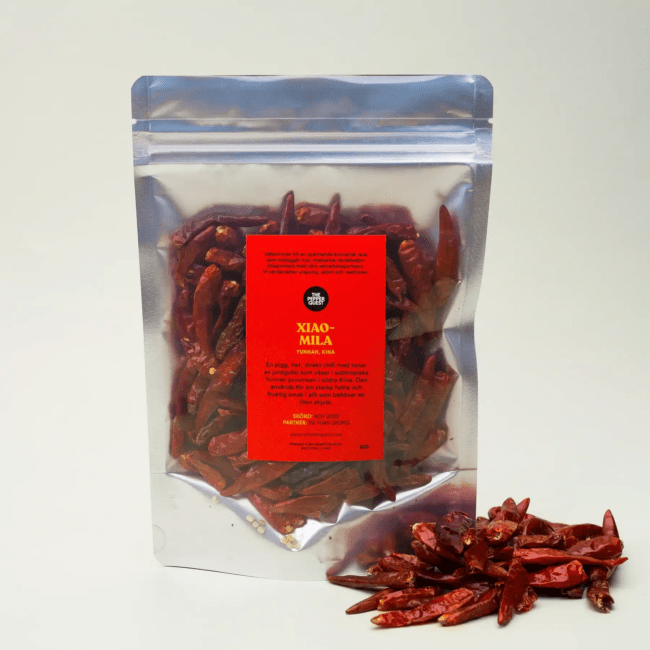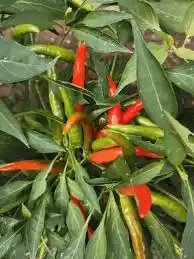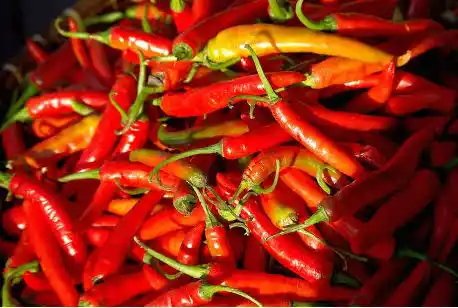Xiao Mi La Pepper, also known as Chinese Sichuan peppercorn, is a spice with a unique flavor profile that holds a special place in Chinese cuisine. Despite its name, Xiao Mi La Pepper is not a true peppercorn but rather the dried husks of the seeds from the prickly ash shrub, scientifically known as Zanthoxylum simulans. These tiny, reddish-brown husks are prized for their aromatic and numbing qualities, which add a distinctive kick to a variety of dishes.
The flavor of Xiao Mi La Pepper is characterized by a citrusy, earthy, and slightly resinous taste. What sets it apart is its ability to induce a tingling or numbing sensation on the tongue, known as “ma” in Chinese cuisine. This unique numbing quality, combined with its citrusy notes, contributes to the complex and bold taste that is integral to many traditional Sichuan dishes.
In Chinese culinary traditions, Sichuan peppercorns are a key component in the famous Sichuan cuisine, renowned for its bold and spicy flavors. The numbing sensation imparted by Xiao Mi La Pepper complements the heat of chili peppers, creating a well-balanced and harmonious flavor profile in dishes such as Mapo Tofu, Kung Pao Chicken, and various hot pots.
Beyond its culinary uses, Xiao Mi La Pepper is also valued for its potential health benefits. In traditional Chinese medicine, it is believed to have properties that can aid digestion, alleviate pain, and even have antibacterial effects. The tingling sensation produced by the peppercorns is thought to stimulate the production of saliva and gastric juices, promoting better digestion.
In recent years, Xiao Mi La Pepper has gained popularity beyond China, finding its way into international kitchens where chefs and home cooks alike experiment with its unique flavor. It is not uncommon to see Sichuan peppercorns incorporated into a variety of dishes, from spice-infused oils to desserts, showcasing the spice’s versatility.
When using Xiao Mi La Pepper in cooking, it is common to lightly toast the peppercorns before grinding or incorporating them into recipes. This process enhances their aromatic qualities and releases their essential oils, intensifying the overall flavor experience.
Xiao Mi La Pepper, or Sichuan peppercorn, is a spice that adds a distinctive and unforgettable element to Chinese cuisine. Its ability to impart both heat and a numbing sensation makes it a sought-after ingredient in kitchens around the world. Whether you’re exploring the vibrant world of Sichuan cuisine or experimenting with international flavors, Xiao Mi La Pepper is sure to leave a lasting impression on your taste buds.
The Botanical Description of Xiao Mi La Pepper
1. Plant Characteristics: Xiao Mi La Pepper, scientifically known as Capsicum annuum var. conoides, is a member of the Solanaceae family. This pepper variety is renowned for its distinctive characteristics, including a conical shape, vibrant coloration, and a pungent flavor profile.
2. Growth Habit: The Xiao Mi La Pepper plant typically exhibits a compact and bushy growth habit. Its height can vary, ranging from one to two feet, making it suitable for cultivation in both garden beds and containers.
3. Leaves and Foliage: The leaves of Xiao Mi La Pepper are generally green, and they alternate along the stems. The foliage is not only ornamental but also contributes to the overall aesthetic appeal of the plant.
4. Fruit Description: The defining feature of Xiao Mi La Pepper is its conical fruits, which are small to medium in size. The peppers start off green and transition through various color stages, including yellow, orange, and finally red when fully ripe.
5. Color Variations: One notable aspect of Xiao Mi La Pepper is the color diversity exhibited by its fruits. The peppers undergo a visually striking transformation as they mature, creating a visually appealing display in gardens and on kitchen counters.
The Geographic Distribution of Xiao Mi La Pepper
1. Origin: Xiao Mi La Pepper is indigenous to certain regions in China, particularly in the southwestern provinces where it has been cultivated for centuries. Its cultivation has expanded beyond its native regions due to its popularity in culinary applications.
2. Global Cultivation: While its origins are in China, Xiao Mi La Pepper has found its way into global cultivation, thanks to its unique flavor profile and adaptability. It is now cultivated in various countries with suitable climates for pepper production.
3. Climatic Preferences: Xiao Mi La Pepper thrives in warm and temperate climates. It is well-suited for regions with a moderate temperature range, receiving adequate sunlight for optimal growth and fruit development.
4. Culinary Influence: Due to its Chinese origin, Xiao Mi La Pepper has a significant presence in Chinese cuisine. However, its popularity has transcended borders, and it is now used in various international dishes, contributing its distinctive flavor to a wide range of culinary creations.
The Chemical Composition of Xiao Mi La Pepper
1. Capsaicin Content: Xiao Mi La Pepper, like many hot peppers, contains capsaicin, the compound responsible for its spicy heat. Capsaicin is not only a key factor in the pepper’s pungency but also contributes to potential health benefits.
2. Vitamins and Minerals: Xiao Mi La Pepper is a rich source of essential vitamins and minerals. It contains significant levels of vitamin C, providing a boost to the immune system. Additionally, it contributes to the intake of minerals such as potassium.
3. Antioxidant Compounds: The vibrant colors of Xiao Mi La Pepper are indicative of its antioxidant content. Antioxidants, including carotenoids and flavonoids, play a crucial role in neutralizing free radicals in the body, potentially offering health benefits.
4. Essential Oils: The aromatic properties of Xiao Mi La Pepper can be attributed to its essential oil content. These oils contribute to the overall flavor and aroma of the pepper, enhancing its culinary appeal.
5. Alkaloid Presence: Xiao Mi La Pepper may contain alkaloids, contributing to its overall chemical composition. Alkaloids are natural compounds that can have diverse effects and are often studied for their potential pharmacological properties.
Read Also: Reasons why Black Currant is good for your Health
The Medicinal Health Benefits of Xiao Mi La Pepper (Capsicum annuum)

1. Anti-Inflammatory Properties: Xiao Mi La Pepper is known for its anti-inflammatory effects, attributed to compounds like capsaicin. These properties may aid in reducing inflammation and associated discomfort.
2. Digestive Health: Consumption of Xiao Mi La Pepper in moderation may contribute to digestive health. It may stimulate digestion and alleviate issues such as indigestion and bloating.
3. Pain Relief: The presence of capsaicin in Xiao Mi La Pepper makes it a potential natural analgesic. Topical applications infused with Xiao Mi La Pepper may provide relief from certain types of pain, such as arthritis discomfort.
4. Respiratory Support: The spiciness of Xiao Mi La Pepper can act as a decongestant, helping to clear nasal passages and provide relief from respiratory conditions like congestion and sinusitis.
5. Weight Management: Some studies suggest that capsaicin in Xiao Mi La Pepper may boost metabolism and promote weight loss. It may assist in fat oxidation and appetite regulation.
6. Cardiovascular Health: Xiao Mi La Pepper may have cardiovascular benefits, including the potential to lower blood pressure and improve blood circulation. However, moderation is crucial, especially for individuals with existing cardiovascular conditions.
7. Rich in Antioxidants: The vibrant colors of Xiao Mi La Pepper signify the presence of antioxidants. These compounds play a vital role in neutralizing free radicals, supporting overall health.
8. Immune System Boost: Xiao Mi La Pepper contains vitamin C, a crucial nutrient for immune system function. Regular consumption may contribute to a strengthened immune response.
The Methods of Usage to Achieve the Provided Health Benefits of Xiao Mi La Pepper
1. Culinary Incorporation: Xiao Mi La Pepper can be included in various culinary creations, adding flavor and potential health benefits. It can be used in sauces, stir-fries, and other dishes.
2. Topical Applications: For pain relief and anti-inflammatory effects, Xiao Mi La Pepper can be infused into topical ointments or creams. These can be applied to areas experiencing discomfort.
3. Herbal Infusions: Create herbal infusions or teas using dried Xiao Mi La Pepper. This method is suitable for those looking to harness its potential digestive and respiratory benefits.
4. Capsule Supplements: Capsule supplements containing Xiao Mi La Pepper extract are available. However, it’s essential to consult with a healthcare professional before incorporating supplements into one’s routine.
5. Tinctures: Tinctures are alcohol-based extracts that capture the medicinal properties of Xiao Mi La Pepper. These can be added to beverages or consumed directly in controlled amounts.
The Side Effects of Using Xiao Mi La Pepper Medicinal Plant
1. Gastrointestinal Discomfort: Excessive consumption of Xiao Mi La Pepper may lead to gastrointestinal discomfort, including stomach pain or irritation. It’s crucial to use it in moderation.
2. Skin Irritation: Topical applications of Xiao Mi La Pepper may cause skin irritation in some individuals. Conduct a patch test before widespread application.
3. Interaction with Medications: Individuals taking medications, especially for cardiovascular conditions, should exercise caution, as Xiao Mi La Pepper may interact with certain drugs.
4. Allergic Reactions: While rare, some individuals may be allergic to components of Xiao Mi La Pepper. Monitor for signs of allergy, such as itching or swelling, and seek medical attention if necessary.
5. Pregnancy Considerations: Pregnant individuals should consult healthcare professionals before incorporating Xiao Mi La Pepper into their diet, as excessive consumption may have implications for pregnancy.
Read Also: How to Protect Farm Crops From the Weather
The Scientific Research and Studies of Xiao Mi La Pepper

1. Anti-Inflammatory Properties: Various research studies have highlighted Xiao Mi La Pepper’s potential anti-inflammatory effects due to its capsaicin content. These properties have shown promise in reducing inflammation in laboratory settings, indicating potential therapeutic applications.
2. Digestive Health: Research suggests that moderate consumption of Xiao Mi La Pepper may promote digestive health. Studies on animals and some human trials have indicated its role in improving digestion by stimulating gastric secretions.
3. Pain Relief: Scientific investigations have focused on Xiao Mi La Pepper’s analgesic properties. Capsaicin, the active compound, has been used in topical creams for pain relief, particularly for arthritis and neuropathic pain.
4. Metabolism and Weight Management: Some studies propose that capsaicin in Xiao Mi La Pepper may enhance metabolism and aid in weight management by promoting fat oxidation and reducing appetite. However, further human trials are needed for conclusive evidence.
5. Cardiovascular Effects: Research suggests Xiao Mi La Pepper might positively influence cardiovascular health by potentially reducing blood pressure and enhancing blood circulation. Yet, these findings require further validation through extensive clinical trials.
6. Antioxidant Properties: Studies have highlighted the antioxidant-rich nature of Xiao Mi La Pepper, contributing to its potential in combating oxidative stress and preventing cell damage.
7. Immune System Support: Xiao Mi La Pepper’s vitamin C content may support the immune system, although extensive research on its specific impact is necessary.
The Safety Precautions and Recommendations in Using Xiao Mi La Pepper Medicinal Plant
1. Moderate Consumption: While Xiao Mi La Pepper has various potential health benefits, excessive intake can lead to gastrointestinal discomfort. It’s advisable to consume it in moderation to avoid adverse reactions.
2. Skin Contact: Direct skin contact or topical application can cause irritation in sensitive individuals. Always perform a patch test before using Xiao Mi La Pepper-infused products extensively.
3. Interaction with Medications: Xiao Mi La Pepper might interact with certain medications, particularly those related to cardiovascular health. Consult a healthcare professional before using it alongside medication.
4. Allergies: Individuals with known allergies to peppers or specific components of Xiao Mi La Pepper should avoid its consumption to prevent allergic reactions.
5. Pregnancy and Nursing: Pregnant or nursing individuals should consult healthcare providers before including Xiao Mi La Pepper in their diet, as its effects during these conditions are not extensively studied.
FAQs About Xiao Mi La Pepper Medicinal Plant
1. Is Xiao Mi La Pepper Safe for Daily Consumption?
Xiao Mi La Pepper is safe in moderation. Excessive intake may lead to digestive discomfort.
2. Can Xiao Mi La Pepper Help with Pain Relief?
Topical applications of Xiao Mi La Pepper may offer relief for certain types of pain due to its capsaicin content.
3. Are There Any Known Allergies to Xiao Mi La Pepper?
Yes, individuals allergic to peppers may also react to Xiao Mi La Pepper. Monitor for any allergic symptoms.
4. What Precautions Should I Take When Using Xiao Mi La Pepper Topically?
Perform a patch test before extensive use to ensure no adverse skin reactions occur.
5. Can Xiao Mi La Pepper Interfere with Blood Pressure Medications?
Xiao Mi La Pepper might interact with certain blood pressure medications. Consult a healthcare professional if you’re on such medications before using it.
Read Also: What Is Agroforestry? Types And Benefits

